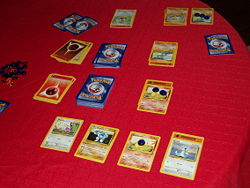Pokémon Trading Card Game
2008/9 Schools Wikipedia Selection. Related subjects: Games
 A Pokémon card game in progress. This content has an uncertain copyright status and is pending deletion. You can comment on its removal. |
|
| Publisher | Wizards of the Coast (October 1996 - July 2003) Pokémon USA, Inc./Nintendo (July 2003 - present) |
|---|---|
| Players | 2-4 |
| Age range | 7+ |
| Setup time | < 3 minutes |
| Playing time | ~ Varies1 |
| Random chance | Some |
| Skills required | Card playing Arithmetic Basic Reading Ability |
|
Footnotes
1 Games may take much longer or shorter depending on a deck's play style. 2Strategy and complexity of play depends greatly on the specific deck's play style and level of competition.
|
|
The Pokémon Trading Card Game (Pokémon TCG) is a collectible card game based on the Pokémon video game series, first introduced in Japan in October 1996, then North America in December 1998. It was initially published by Wizards of the Coast, the company that produces Magic: the Gathering. Although Wizards of the Coast lost the licence to publish the game in July 2003, sets continue to be published under the jurisdiction of Nintendo and Pokémon USA, Inc. (PUI).
Game concepts
The game is centered on the concept of the Pokémon battle. All Pokémon cards have attacks and Hit Points (HP) except for energy cards and trainer cards; by doing damage to the opponent's Pokémon equal to their Hit Points, the player can knock them out and send them to the discard pile.
Victory conditions
There are three different ways to win a game:
- The first type of win condition is to retrieve a set of "prize cards". A number of cards (usually six) are set aside from the top of each player's deck at the beginning of each game. Each time a player knocks out an opponent's Pokémon, he or she puts a prize card into his or her hand. Pokémon-ex cards, introduced in EX: Ruby and Sapphire, are more powerful than their non-ex counterparts, but allow a player who knocks them out to take two prize cards instead of one.
- Second, a player loses if his or her active Pokémon (the one currently conducting battle) is knocked out and he or she has no other Pokémon in play.
- Third, a player must draw a card from the top of the deck at the beginning of his or her turn, and therefore loses if there are no cards remaining in the deck at the beginning of the turn. This is a trend common to most trading card games.
Card types
There are five types of cards in the Pokémon Trading Card Game: Pokémon cards, Energy cards, Trainer cards, Stadium cards, and Supporter cards. Though only Pokémon cards are necessary in a deck, both Energy cards and Trainer cards are important to achieving victory. A player's 60-card deck may only contain four cards with the same name, with the exception of Basic Energy cards.
Pokémon cards
Pokémon cards are the basis of all decks. Without them a player cannot play the game, since both players begin the game by placing a basic Pokémon in the active position on the playing field. Each Pokémon card depicts a Pokémon from the video games. Each player may have up to six Pokémon on the playing field at a time: one “active” Pokémon and up to five on the bench (these are considered to be in reserve, but they can still affect the gameplay). Each Pokémon card has a name, type, amount of Hit Points, level of evolution, attack(s), weakness, resistance, retreat cost, and flavor text. Some Pokémon have effects, called Poké-Powers or Poké-Bodies, that are not attacks but can affect gameplay; occasionally a Pokémon will have no attacks. From Diamond & Pearl onwards, each Pokémon's level is given next to its name, although not part of the name itself (e.g. Magnezone LV.48).
Most Pokémon feature attacks that deal damage to the opponent's active Pokémon, or occasionally, their benched Pokémon; still others perform different functions, such as manipulating players' possession of cards. The vast majority of these attacks require Energy, which comes in the form of Energy cards, though the occasional Pokémon may have an attack that requires no energy (these attacks typically are weak or perform a function other than damage). Once per turn, players can use one of their active Pokémon's attacks.
The two types of Pokémon cards are Basic Pokémon and evolution cards. Basic Pokémon are Pokémon that have not evolved, and can be played directly onto the Bench. Each deck must have at least one Basic Pokémon to be considered legal. In contrast, an evolution card represents a Pokémon that has evolved. Unlike Basic Pokémon, evolution cards cannot be placed directly onto the field (unless something happens that allows one to do so); they must be played on the corresponding Basic Pokémon. Stage 1 Pokémon evolve from Basic Pokémon, and Stage 2 Pokémon evolve from a Stage 1 Pokémon. As a Pokémon evolves, it gains HP and can use Energy more effectively.